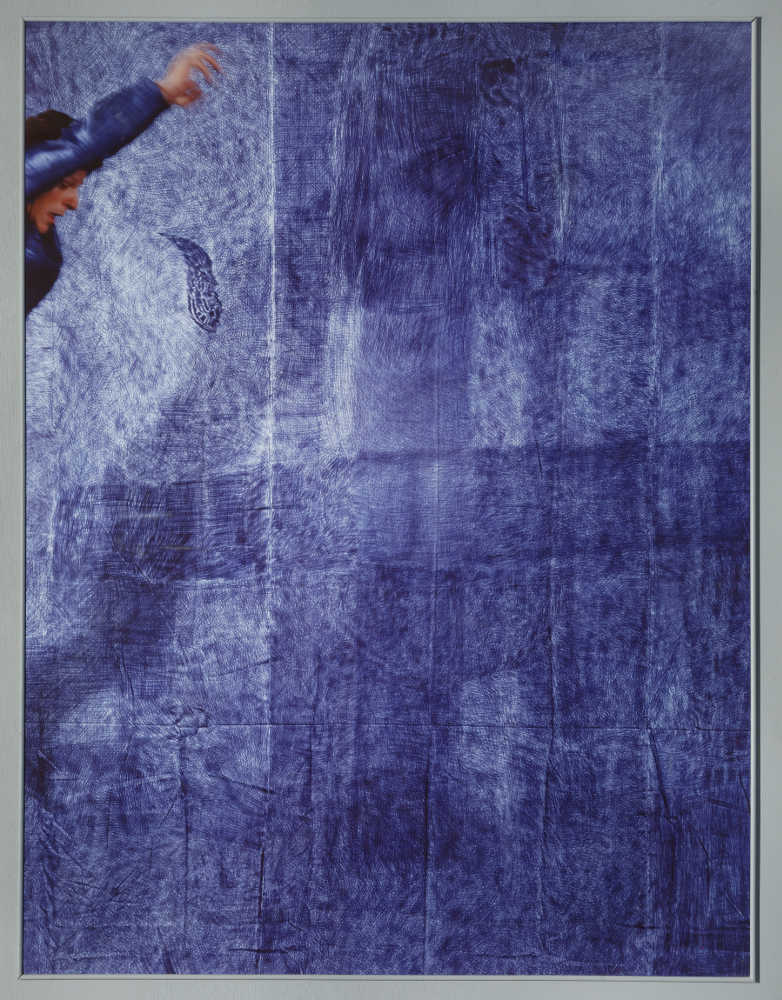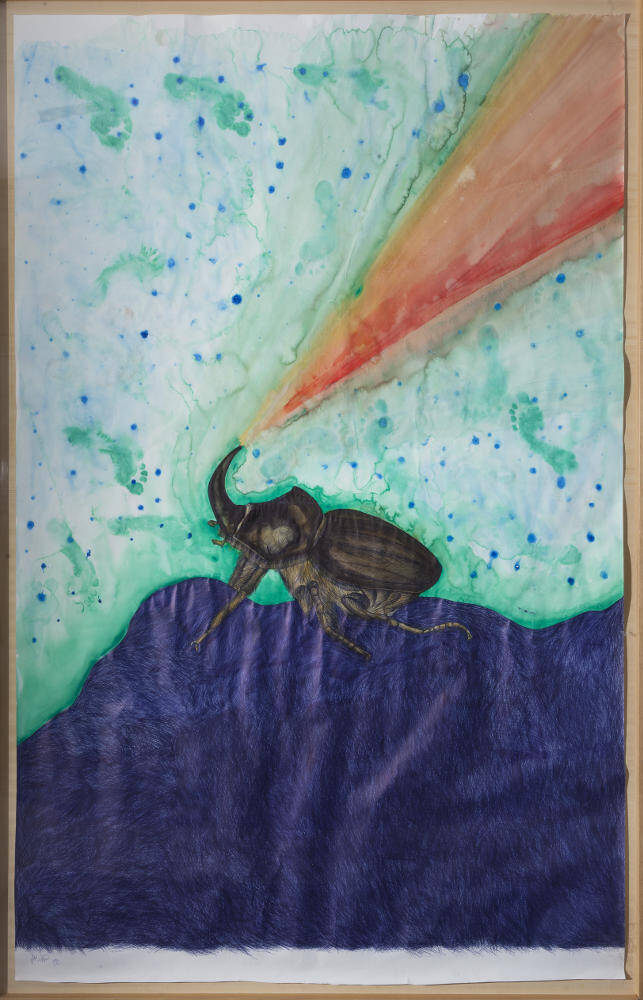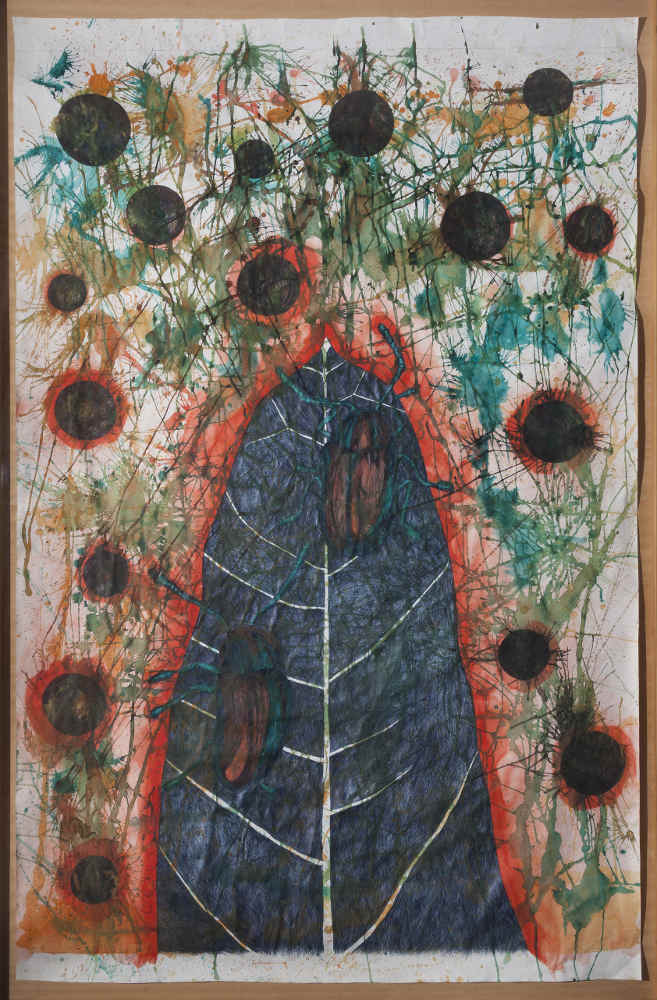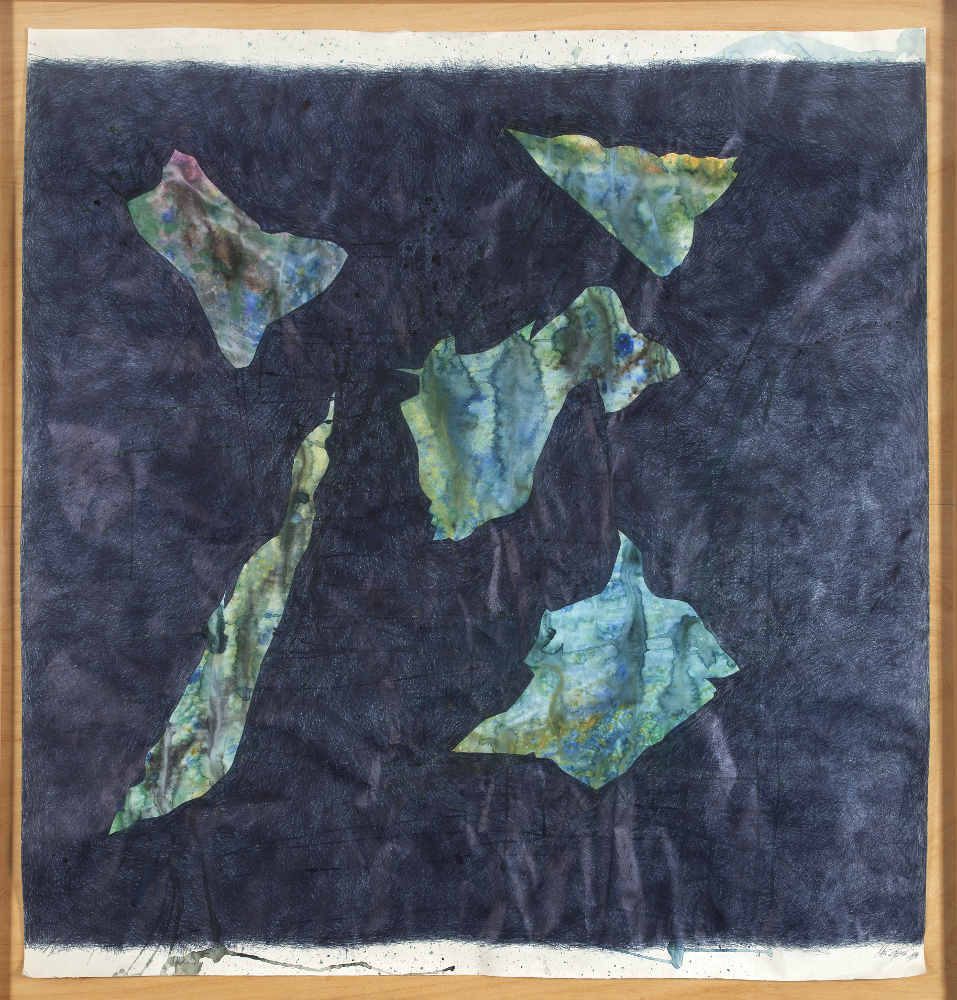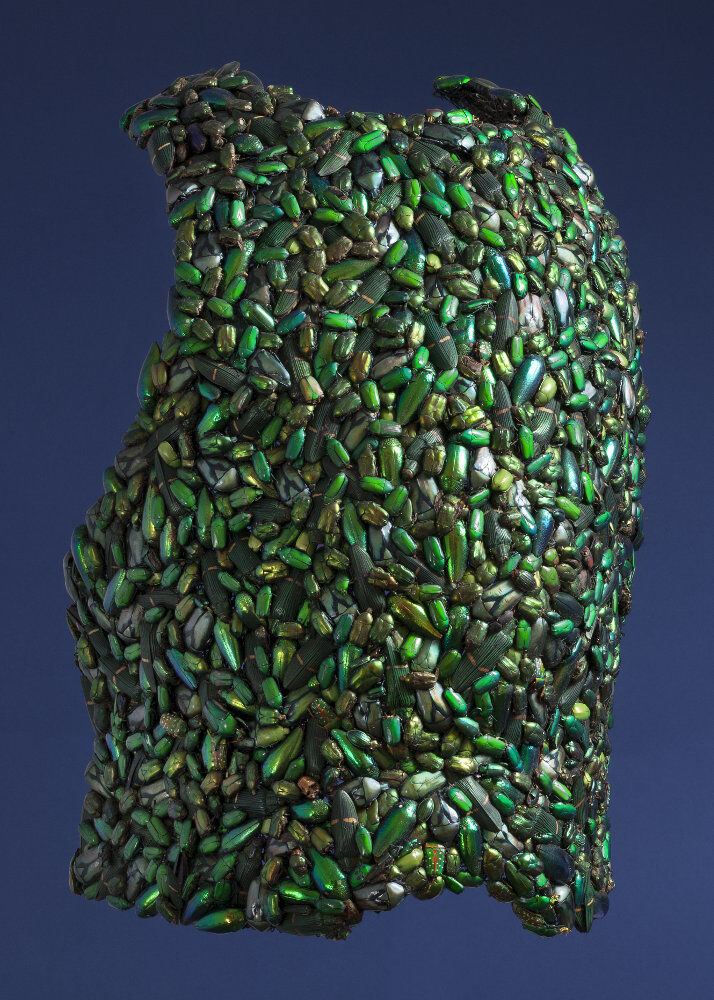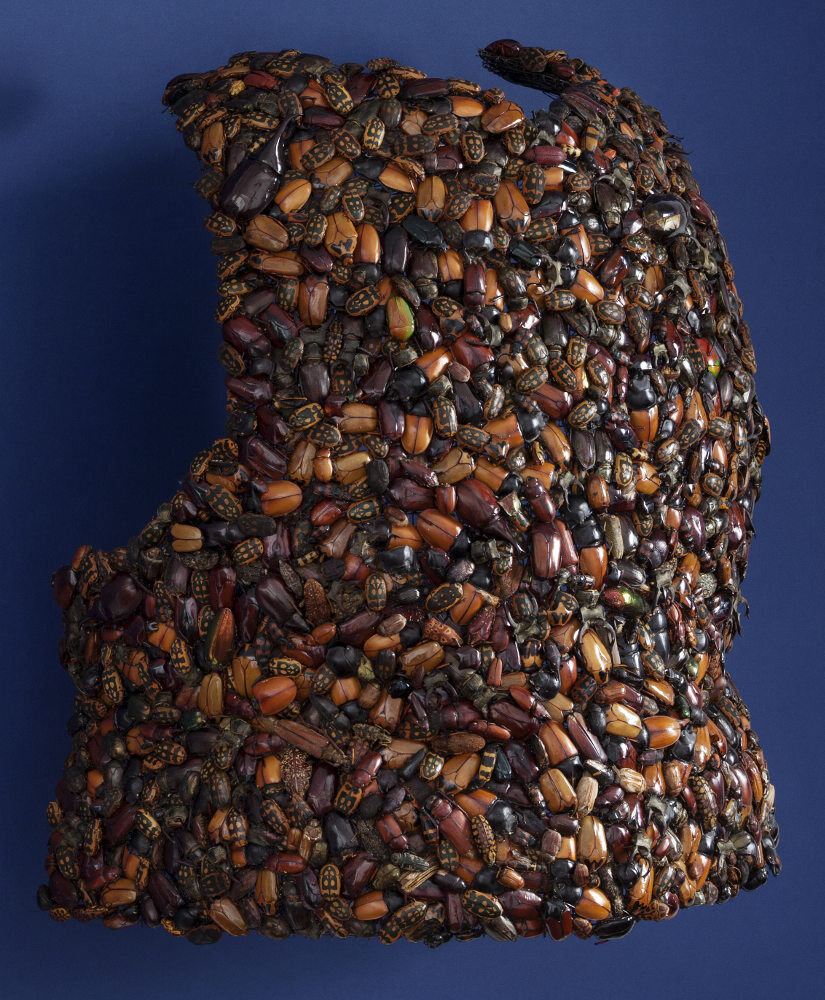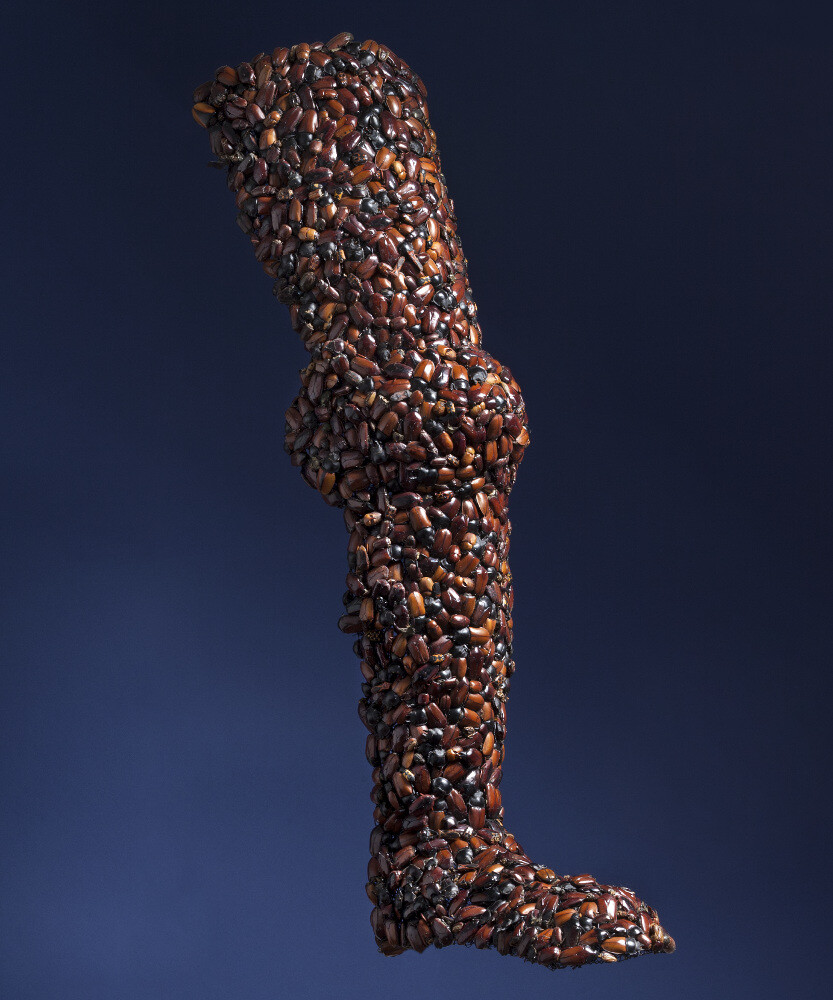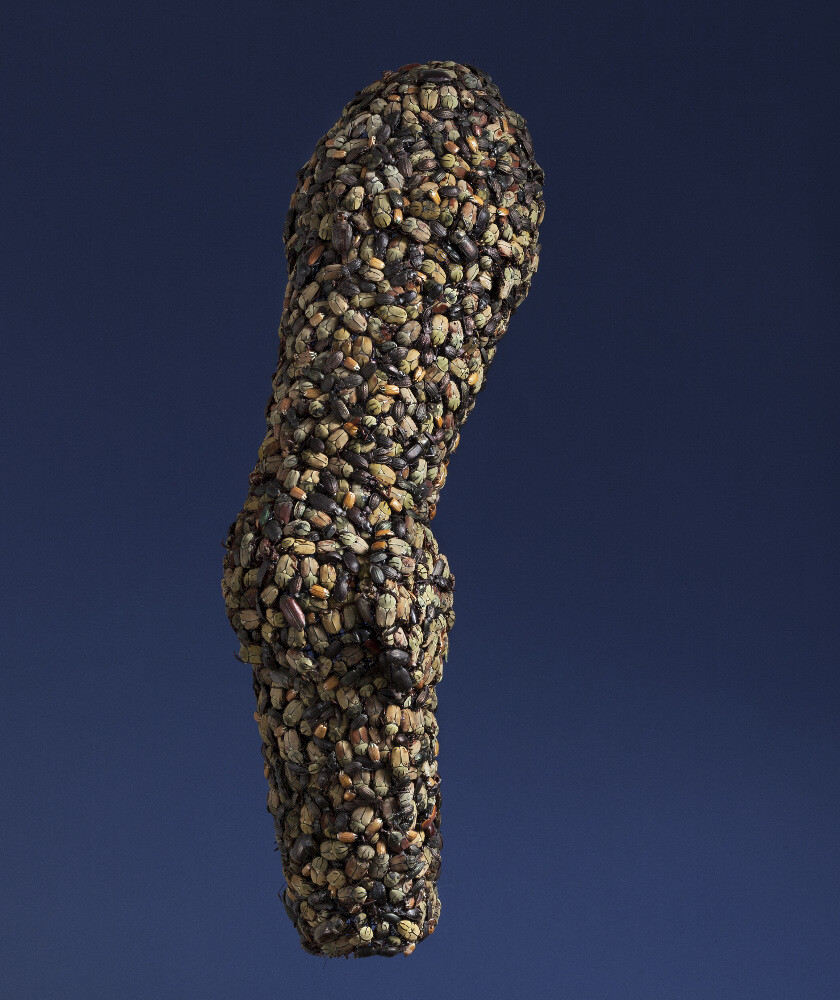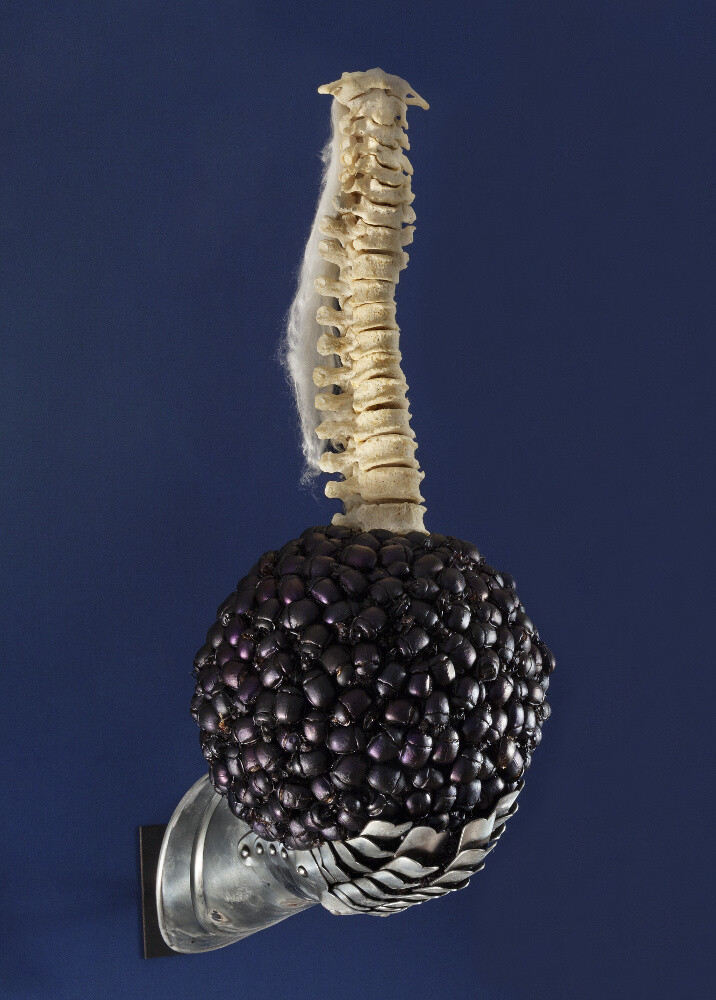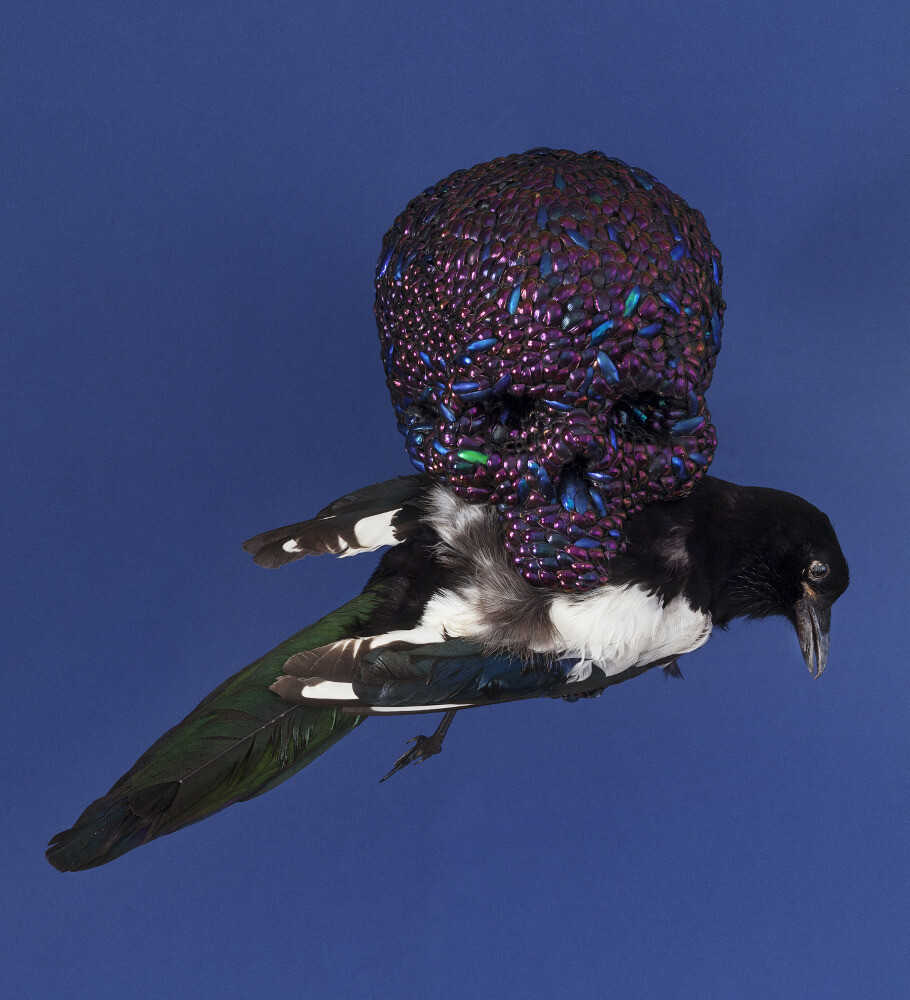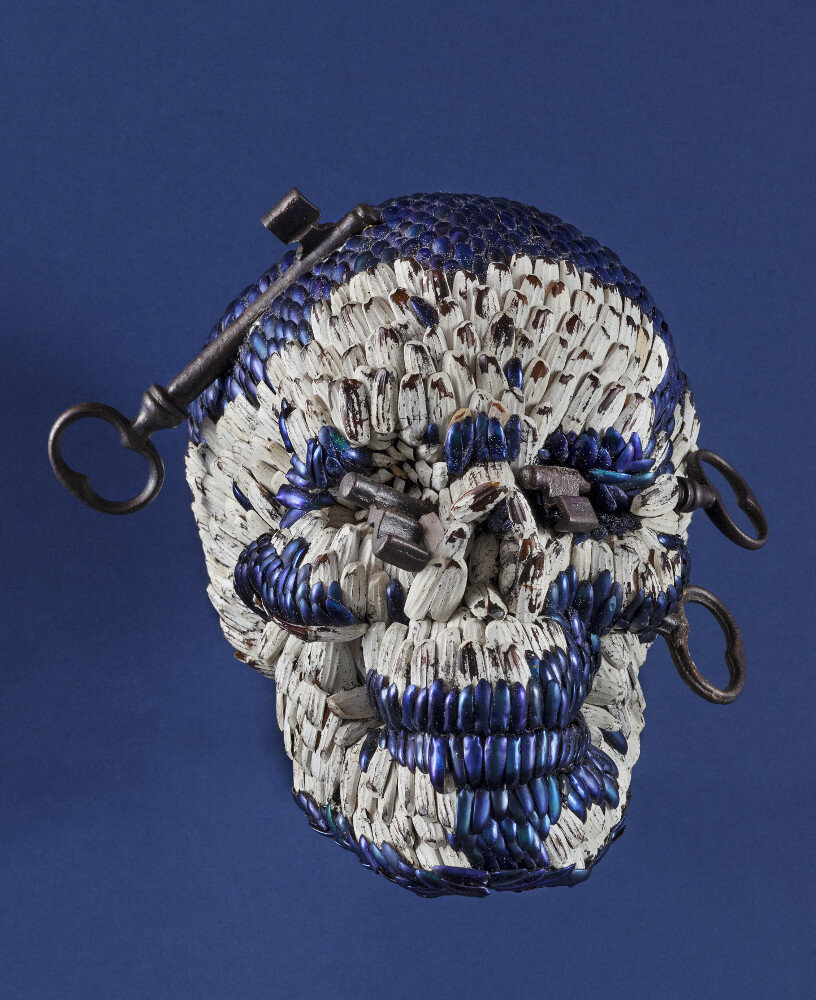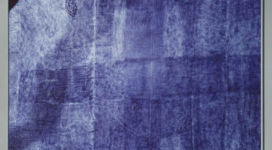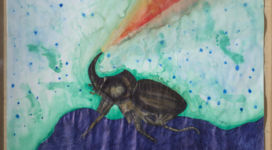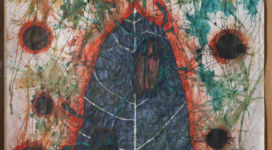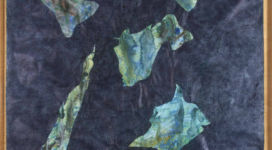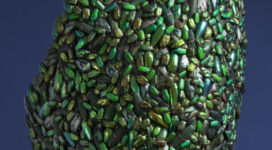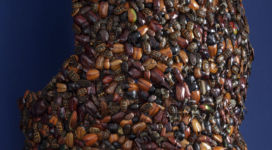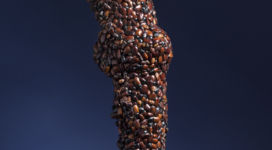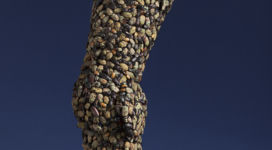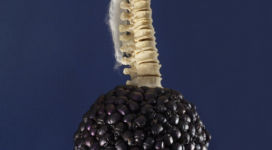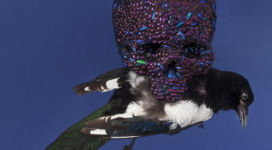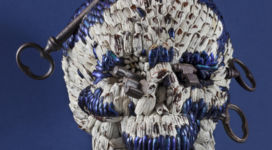| JAN FABRE | Exhibition 2015 | |
| Close up 2016 | ||
| Catalog |
Jan Fabre (b. 1958, Antwerp) is regarded both in Belgium and abroad as one of the most innovative and versatile personalities in the contemporary international art scene. Over the past 40 years, he has made his mark as a visual artist, theatre artist and author. He describes himself as a consilience artist, explaining: “It’s a merging of elements from different disciplines guided by fact-based theory and practice across disciplines. An understanding of entomology can, for example, lead to new interpretations within the visual arts. Or vice versa – you see connections (for example across art, theatre, science, religion, medicine, politics), you make new interpretations. This is consilience.” Thanks to this undertaking, Fabre offers fresh interpretations to the world of visual art, theatre and literature.
Jan Fabre changed the idiom of theatre by bringing real action and real time onto the stage. Following his historic eight-hour production ‘This is theatre like it was to be expected and foreseen’ (1982) and the four-hour ‘The Power of Theatrical Madness’ (1984), he explored new territory with ‘Mount Olympus. To glorify the cult of tragedy, a 24-hour performance’ (2015); a monumental marathon piece with which he rewrote international theatre history.
In his visual oeuvre, Fabre has developed a unique and coherent universe; a highly personal visual language with recurring symbols and motifs. Whilst studying in Antwerp at the Royal Academy of Fine Arts and the Municipal Institute for Decorative Arts and Crafts, he developed a profound love of beauty and its spiritual power. Curious by nature and influenced by the manuscripts of the entomologist Jean-Henri Fabre (1823-1915), he became fascinated by the world of insects at a young age.
The iconic artworks featuring the iridescent wing-cases of the jewel beetle are an example of how Fabre wields metamorphosis as one of his driving forces. Thanks to its external skeleton and description in age-old mythologies, the jewel beetle has a long life, both physically and spiritually. The mosaic artworks in which the artist uses the wing shells as a base are also created to endure. The constantly changing play of light on these works, for example in the famous ceiling installation ‘Heaven of Delight’ in Brussels’ Royal Palace (2002) or in the three new altarpieces in AMUZ, the former St. Augustine’s Church in Antwerp (2018), engenders a continuous subtle metamorphosis.
The two series of mosaic panels ‘Tribute to Belgian Congo’ (2010-2013) and ‘Tribute to Hieronymus Bosch in Congo’ (2011-2013) are made from the same wing-cases of the jewel beetle. With these works he addresses Belgium’s controversial history. They were first exhibited in their entirety at the PinchukArtCentre in Kiev (2013). Subsequently, they were shown at venues including the Palais des Beaux-Arts in Lille (2013) and in ’s-Hertogenbosch to commemorate the 500th birthday of Hieronymus Bosch (2016).
The interaction between human and animal, and between animal and human, is an important component of metamorphosis, and is thus a constant in Fabre’s body of thought. He does not only admire insects; the intelligent turtle is also a source of lively fascination for the artist. With actions and performances, series of drawings, objects, sculptures and various landscape installations, he observes and depicts this primitive animal as a guide to an unconstrained existence.
In 2018 the turtle was a core part of Fabre’s exhibition ‘Ecstasy and Oracles’ at various locations in Sicily. The animal also reappears in a number of permanent artworks in the public space; the mosaics of the turtles Janneke and Mieke welcome visitors at the entrance pavilion to the Antwerp Zoo (2012), and we also encounter a turtle by the artist at the Belgian coast: his ‘Searching for Utopia’ (2003) in Nieuwpoort comprises a self-portrait seated atop a gold giant turtle, ready to embark upon a utopian voyage of discovery. Since 2015, ‘Searching for Utopia’ has also been on display in Namur. The bronze artwork was installed in the citadel during the exhibition ‘Facing Time. Rops/Fabre’ and afterwards stayed there permanently.
Fabre has been invited to integrate artworks into various public locations in Belgium and abroad. ‘Totem’ (2004), an installation depicting a jewel beetle on the Ladeuzeplein in Leuven, became a symbol of the city. ‘The Man Who Measures the Clouds’ (1998) commands the view of the S.M.A.K. in Ghent and the 21st Century Museum of Modern Art in Kanazawa. In Antwerp, the artist’s hometown, one encounters ‘The Man Who Bears the Cross’ (2015) in the Cathedral of Our Lady. In Brussels, one can experience ‘The Gaze Within (the Hour Blue)’ (2011-2013) in the stairwell of the Royal Museum of Fine Arts. The four murals, set opposite one another, comprise four obscure views of figures that the artist regards as central to his oeuvre: the beetle, the butterfly, the woman and the owl. His most recent public installations are four red coral sculptures in the chapel of Pio Monte della Misericordia in Naples (2019). With these, Fabre immortalises himself in the company of the already present master Caravaggio.
Research into the meaning of the body is essential in the oeuvre of Jan Fabre: the body is the entrance to every emotion, thought and higher contemplation. The material aspects of the body also intrigue the artist: the organs, the skeleton and bodily fluids such as blood, tears and sperm became both the subject of and materials for his visual art and theatre.
The most frequently depicted organ in Fabre’s oeuvre is the brain, the key to the imagination and therefore to art. In 2007, together with scientist E.O. Wilson, he created the performance film ‘Is the Brain the Most Sexy Part of the Body?’, in which they both philosophise about the workings and meanings of the brain. Fabre explores his brain both literally and figuratively, among others in numerous drawings and images. A selection of these formed the core of the exhibition ‘My nation: the imagination’ at Fondation Maeght in Saint-Paul de Vence (2018).
Fabre uses interventions on his own body to explore its fluid boundaries. This is an endless quest for the self, the shell which serves as the entrance to deeper contents. The artist’s enduring fascination with the body is also strongly apparent in the personal actions and performances, from 1976 to today. Germano Celant curated the ‘Stigmata’ exhibition at MAXXI, Rome in 2013; M HKA, Antwerp in 2015; MAC, Lyon in 2016; Leopold Museum, Vienna in 2017; CAAC, Seville in 2018.
From the late seventies, Fabre has used the Bic ball-point pen as a medium for his visual art. It is cheap, ubiquitous and thus a perfect instrument for a young artist. He has used it to create small, large-scale and even public works. In a nod to Dalí, he describes himself as ‘Ilad of the BIC-Art’. He derives the concept of ‘the hour blue’, the magical and fragile moment between night and sunrise, from the scientist Jean-Henri Fabre. The ball-point pen and the mystical quality of the colour blue continue to be a recurring aspect in his oeuvre. With his well-known visual ensemble ‘The Hour Blue’ (1977-1992) he travelled to venues including the Kunsthistorisches Museum in Vienna (2011), the Musée d’Art Moderne in Saint-Etienne (2012) and the Busan Museum of Art (2013).
Fabre made his first ball-point pen drawings in the public space whilst wandering around Antwerp at night. The artist recorded his night-time reveries and wanderings in the so-called ‘Night Diaries’, which have since been translated into multiple languages. Into these he incorporates his experiences, his fears, his deepest longing, and existential questions. These bundles offer crucial clues to the interpretation of his entire visual and theatrical oeuvre.
Various international solo exhibitions have been milestones in the oeuvre of the versatile Belgian artist. Fabre was the first living artist to put together a large-scale exhibition at the Louvre (‘The Angel of Metamorphosis’, 2008). He was invited by Dr. Mikhail Piotrovsky to create a large-scale exhibition at The State Hermitage Museum in St Petersburg, where in ‘Jan Fabre. Knight of Despair/Warrior of Beauty’ (2016-2017) he entered into a dialogue with some of his key sources of inspiration: The Flemish Masters Rubens, Jordaens and Van Dyck. In 2016 and 2018, he unveiled two solo exhibitions at various locations in Italy. With ‘Spiritual Guards’ (2016) he combined sculpture, drawings, installations, performance and film at three historic locations in the city of Florence: the Forte Belvedere, the Palazzo Vecchio and the Piazza della Signoria. In ‘Ecstasy and Oracles’, various venues in Agrigento and Monreale (Sicily) were linked by Fabre’s works. ‘Glass and Bone Sculptures 1977-2017’, also in Italy, ran parallel to the 57th Venice Biennale (2017). On the occasion of the 58th Venice Biennale (2019), he created a 9 metre high, golden version of ‘The Man who Measures the Clouds (Monument to the Measure of the Immeasurable)’ specifically for its location at the Grand Canal. In the same year, the exhibition ‘Oro Rosso. Gold and coral sculptures, blood drawings’ was on display at different locations in Naples.
As well as being a visual artist and a theatre artist, Jan Fabre is also a respected author. His large oeuvre of theatre texts is regarded as a reference by theatre directors, academics and performers alike. The Jan Fabre Teaching Group passes on his theatre texts and specific language of ‘physiological acting’, as an instrument to new generations of artists all over the world. Throughout his life and career, the artist also continues to write literary texts. His daily personal musings and (often poetic) thoughts are collected in the ‘Night Diaries’, which have been published in several languages worldwide.
SOLO EXHIBITIONS
1979
– Wetskamer, Gallery Workshop 77, Antwerp
– Bic Dweilen en Wetspotten, Jordaenshuis, Antwerp
1980
– Mond-Oog-Oor Arts (Will Doctor Fabre cure you?), Gallery Workshop 77, Antwerp
– American Works and Window Performance, Gallery Blanco, Antwerp
1981
– Ilad of the Bic Art, The Bic Art Room, Salon Odessa, Leiden
– Play art life, School of Visual Arts, New York
– Homo Fabere, Cultureel centrum Ter Dilft, Bornem (cat.)
1982
– The Money Art Exhibition, Zeno X Gallery, Antwerp
– Money and Art or Art and Money, School of Visual Arts, New York
1984
– Jan Fabre. Vrienden…, Provinciaal Museum, Hasselt (cat.)
– Jan Fabre in Belgisch Paviljoen, Belgian Pavillon, Giardini della Biennale, 41. Biennale di Venezia, Venice (cat.)
1985
– Jan Fabre. Tekeningen, Museum van Hedendaagse Kunst, Ghent (cat.)
– The Forgery of the Secret Feast, New Math Gallery, New York (cat.)
1987
– Het Uur Blauw, De Selby, Amsterdam (cat.)
– Jan Fabre, Das Belgische Haus, Cologne (cat.)
1988
– Jan Fabre. Der blaue Raum, Künstlerhaus Bethanien, Berlin
– Hé wat een plezierige zottigheid!, Galerie Ronny Van de Velde, Antwerp (cat.)
– Jan Fabre: Modellen 1977-1985, Deweer Art Gallery, Otegem (cat.)
1989
– Jan Fabre. Insecten en Ruimte, Museum Overholland, Amsterdam (cat.)
– Jan Fabre. Een skulptuur / vijf tekeningen, Deweer Art Gallery, Otegem (cat.)
– Jan Fabre, Jack Tilton Gallery, New York (cat.)
– Tekeningen, Modellen & Objecten, Provinciaal Museum voor Moderne Kunst, Ostend (cat.)
1990
– Jan Fabre. Tivoli, Galerie Ronny Van de Velde, Antwerp
– Jan Fabre. Das Geräusch, Kunsthalle Basel, Basel (cat.)
– Jan Fabre. Som, Centro de Arte Moderna, Lisbon
– Antichambres / Affinités sélectives VI. Jan Fabre / Christian Boltanski, Palais des Beaux-Arts, Brussels
1991
– Jan Fabre. Zwei Objekten, Schirn Kunsthalle Frankfurt, Frankfurt am Main
1992
– Jan Fabre. Zeichnungen – Objekte – Zeichnungen, Kunstverein Hannover, Hannover (cat.)
– Jan Fabre. Een portret, Deweer Art Gallery, Otegem (cat.)
1993
– Jan Fabre. Tekeningen, sculpturen, tekeningen, Galerie Ronny Van de Velde, Antwerp (cat.)
1994
– The Grave of the Unknown Computer, Beaumontpublic Gallery, Luxembourg (cat.)
– Questa pazzia è fantastica, Museo Pecci, Prato (cat.)
– Mauer der aufsteigenden Engel. Skulpturen und Zeichnungen, Galerie Bernd Klüser, Munich
– Silenzio nella tempesta…, Galleria Massimo Minini, Brescia
1995
– Dÿe den nest weet Dÿe weeten. Dÿen roft dÿ heeten. Vier nieuwe sculpturen, De Vleeshal, Middelburg (cat.)
– De Lijmstokman, Stedelijk Museum, Amsterdam
– Der Leimrutenmann, Galerie der Stadt Stuttgart, Stuttgart (cat.)
1996
– Skeleton + Skin, Satani Gallery, Tokyo
– Passage, Ludwig Múzeum, Budapest
1997
– Passage / Prolaz, Muzej Suvremene Umjetnosti, Zagreb
– The Joker, Galleria Massimo Minini, Brescia
– The Lime Twig Man, Arnolfini, Bristol
– Passage, M HKA, Antwerp (cat.)
– Inneres / äußeres Skelett. Skulpturen und Zeichnungen, Galerie Bernd Klüser, Munich
– Jan Fabre, Rob Scholte, Edward Lipski. New Works (3 solo’s), Galerie Ronny Van de Velde, Antwerp
1998
– Jan Fabre & Ilya Kabakov. Een ontmoeting / Vstrecha / A Meeting, Deweer Art Gallery, Otegem (cat.)
– Passage, Haggerty Museum of Art, Milwaukee
– A cidade e as estralas. Parte 3. Jan Fabre. Atlas of battles, strategies and tactics, Galeria Lúis Serpa, Lisbon
– Jan Fabre, Satani Gallery, Tokyo
– Annonce au monde extérieur, Beaumontpublic Gallery, Luxembourg
1999
– Jan Fabre, Muzeum Sztuki Nowoczesnej w Warszawie, Warsaw
– Battlefields & Beekeepers, Deweer Art Gallery, Otegem (cat.)
– Body Liquids &… Sleep, sleep and sleep little animals…, Sprengel Museum, Hannover
– Passage, Cantieri culturali allo Zisa, Palermo (cat.)
– Engel und Krieger. Strategien und Taktiken, Kunsthalle zu Kiel, Kiel (cat.)
– Me Dreaming, Château d’Orion, Orion
2000
– Storage Room of a Warrior, Alpha Delta Gallery, Athens
– A Consilience, Natural History Museum, London
– Jan Fabre & Ilya Kabakov. Sustret. Een ontmoeting / Bctpe4a, Muzej Suvremene Umjetnosti, Zagreb
– Annonce au monde extérieur, Galerie Daniel Templon, Paris
2001
– Swords, Skulls and Crosses, Galeria Espacio Minimo, Madrid (cat.)
– Umbraculum. Een plaats in de schaduw waar gedacht en gewerkt wordt, ver van het gangbare leven, Deweer Art Gallery, Otegem (cat.)
– Ilad of the Bic Art 1980, Galerie Elisabeth Kaufmann, Zürich
– Angel and Warrior. Strategy and Tactics, MIMOCA, Kagawa
– Memento Mori, Beaumontpublic Gallery, Luxembourg
– Umbraculum. Un lieu ombragé hors du monde pour penser et travailler, Chapelle Saint-Charles, Avignon (cat.)
– Jan Fabre. Neue Arbeiten, Galerie Bernd Klüser, Munich
– Progetto Roma 2001, Umbraculum. Un posto ombreggiato dove pensare e lavorare lontano della vita quotidiana, Galleria Comunale d’Arte Moderna e Contemporanea, Rome (cat.)
– L’uomo che misura le nuvole – l’uomo dalle gambe di carne, Academia Belgica, Rome
2002
– Gaude succurrere vitae (Verheug u ter hulp te komen aan het leven), S.M.A.K., Ghent (cat.)
– The Great Confinement, Galerie Academia & MAM Mario Mauroner Contemporary Art, Salzburg (cat.)
2003
– Umbraculum, Kunstnernes Hus, Oslo (cat.)
– Sanguis / Mantis, Galerie Daniel Templon, Paris
– Gaude succurrere vitae (Rallegratevi di soccorrere la vita), GAMeC, Bergamo (cat.)
– Gaude succurrere vitae (Alegrate de socorrer la vida), Fundacio Joan Miró, Barcelona (cat.)
– L’homme qui donne du feu. Un choix dans l’œuvre sculpturale de Jan Fabre 1977-2003, Fondation Claudine et Jean-Marc Salomon, Alex
– A la recherche d’Utopia. Sculptures / installations 1977-2003, MAMAC, Nice
2004
– Umbraculum, DASA, Dortmund (cat.)
– Jan Fabre. Drawing – Photography – Drawing 1978-2004, Beaumontpublic Gallery, Luxembourg (cat.)
– Messengers of the Death, MAM Mario Mauroner Contemporary Art, Salzburg (cat.)
– Gaude succurrere vitae (Réjouissez-vous de venir au secours de la vie), Musée d’Art Contemporain, Lyon (cat.)
– Sanguis / Mantis, MAM Mario Mauroner Contemporary Art, Vienna (cat.)
– The Problem, Alpha Delta Gallery, Athens
2005
– Mis gotas de sangre, mis huellas de sangre, Galeria Espacio Minimo, Madrid
– Il rifugio (per la tomba del computer sconosciuto), Casa La Marrana in Montemarcello, Ameglia (cat.)
2006
– Le temps emprunté, Beaumontpublic Gallery, Luxembourg (cat.)
– Kijkdozen en Denkmodellen 1977-2004, Vlaams Parlement, Lokettenzaal, Brussels (cat.)
– Homo Faber, M HKA; KMSKA; Stadsbibliotheek; Galerij Rode Zeven & Galerij Rossaert, Antwerp (cat.)
– Lancelot, Magazzino, Rome
– L’home que escriu sobre l’aigua, Sala d’Exposicions de la Rambla, Girona
– Je me vide de moi-même, Galerie Guy Bärtschi, Geneva
– Landscapes and Turtles, Deweer Art Gallery, Otegem
– An Umbraculum for Dubrovnik, Galerija Umjetnicka, Dubrovnik
– Turtles, Carpets, Landscapes, Galerie Artist, Istanbul
2007
– Je crache sur ma tombe (modèle de pensée), MAM Mario Mauroner Contemporary Art, Vienna
– Die verliehene Zeit. Dessins pour l’œuvre scènique de Jan Fabre, Museum der Moderne Rupertinum, Salzburg (cat.)
– Jan Fabre. Projet Tivoli pour Salzburg, MAM Mario Mauroner Contemporary Art, Salzburg
– Boîtes à images et modèles de pensée, MAM Mario Mauroner Contemporary Art, Salzburg
– Who Shall Speak My Thoughts (of My Body), Gallery Alpha Delta, Athens
– The Brains of My Mother and My Father / The Most Sexy Part of the Body (Brain Drawings and Models), Shugoarts, Tokyo
– Les messagers de la mort décapités, Galerie Daniel Templon, Paris
– Antropologia di un pianeta, GAMeC, Bergamo; Palazzo Benzon, 52. Biennale di Venezia, Venice (cat.)
2008
– De geleende tijd / Le temps emprunté, BOZAR, Brussels (cat.)
– Jan Fabre au Louvre. L’ange de la métamorphose, Musée du Louvre, Aile Richelieu, Salles Écoles du Nord, Paris (cat.)
– Is the Brain the Most Sexy Part of the Body?, Deweer Art Gallery, Otegem
– La route de la terre vers les étoiles n’est pas lisse, Halle Verrière, Meisenthal
– From the Cellar to the Attic – From the Feet to the Brain, Kunsthaus Bregenz, Bregenz (cat.)
– Jan Fabre. Premio Pino Pascali XII ediz. 2008, Palazzo Pino Pascali, Polignano a Mare (cat.)
– Umbraculum para Santiago de Chile, MAC, Parque Forestal, Santiago de Chile
– Il Ragazzo con la luna e le stelle sulla testa, Piazza Plebiscito, Naples
2009
– Project Mesrine & Is the Brain the Most Sexy Part of the Body?, Galerie Bernd Klüser, Munich
– Umbraculum para La Paz Bolivia, un lugar para pensar y escribir, Museo Municipal Tambo Quirquincho, La Paz
– The Borrowed Time, Museum of Modern Art Dubrovnik, Dubrovnik (cat.)
– From the Feet to the Brain, Arsenale Novissimo, 53. Biennale di Venezia, Venice (cat.)
– La metamorfosi dell’artista (Omaggio a Jacques Mesrine), Magazzino, Rome
– Jan Fabre. Thinking Models, Galerie Beaumontpublic, Luxembourg (cat.)
2010
– Umbraculum para Medellin, un lugar en la sombra para reflexionar y trabajar, MAMM, Medellin
– Le temps emprunté, Museo Carlo Bilotti Aranciera di Villa Borghese, Rome (cat.)
– Jan Fabre. Chapitres I -XVIII. Cires & Bronzes, Guy Pieters Gallery, Paris (cat.)
– Jan Fabre. Brain Drawings & Models, Galerie Clara Maria Sels, Düsseldorf
– Alternative humanities: Jan Fabre & Katsura Funakoshi, 21st Century Museum of Contemporary Art, Kanazawa (cat.)
– De geleende tijd, Museum de Fundatie, Zwolle (cat.)
– Art kept me out of jail. Performance installations by Jan Fabre 2001-2004-2008, M HKA, Antwerp (cat.)
– Umbracululm para São Paulo, um lugar na sombra para pensar e trabajar, Instituto Tomie Ohtake, São Paulo
– Is the Brain the Most Sexy Part of the Body?, Topkapi Palace, Istanbul
2011
– Hortus / Corpus, Kröller-Müller Museum, Otterlo (cat.)
– The Carnival of the Dead Streetdogs & The Catacombs of the Dead Streetdogs, Galerija Vzigalica, Ljubljana (cat.)
– Borrowed Time – Photographs and Drawings, Mestna Galerija – Mgml; City Art Museum, Ljubljana (cat.)
– Umbraculum, Tobacna 001 Cultural Centre, Galerija 001, Ljubljana (cat.)
– Chimères & Portrait d’un artiste en évasion, Galerie Daniel Templon, Paris
– The Jewels of Death. Bic Blue Drawings, MAM Mario Mauroner Contemporary Art Gallery, Vienna
– Die Jahre der Blauen Stunde, Kunsthistorisches Museum, Vienna (cat.)
– Pietas, Nuova Scuola Grande di Santa Maria della Misericordia, 54. Biennale di Venezia, Venice (cat.)
– Art kept me out of jail, Muzeum Sztuki Lodz, Lodz (cat.)
– Brain Models and Drawings by Jan Fabre, 3rd Thessaloniki Biennale of Contemporary Art, Thessaloniki Concert Hall-Building M2, Thessaloniki (cat.)
– Tribute to Hieronymus Bosch in Congo, Magazzino, Rome
2012
– Les années de l’Heure Bleue. Dessins et sculptures, 1977-1992, Musée d’Art Moderne de Saint-Etienne Métropole, Saint-Etienne (cat.)
– Art kept me out of jail. Performance installations by Jan Fabre 2001-2004-2008, UGM | Maribor Art Gallery, Maribor (cat.)
– Pietas, Parkloods, Park Spoor Noord, Antwerp (cat.)
– Offering to the God of Insomnia, MAM Mario Mauroner Contemporary Art, Salzburg
– Tribute to Hieronymus Bosch in Congo, MAM Mario Mauroner Contemporary Art, Salzburg
– Jan Fabre. Kerkmeester, De Nieuwe Kerk, Amsterdam
– Pride Comes Before a Fall of the Lash, Gallery 604, Busan (cat.)
– Zeno Brains and Oracle Stones, MAM Mario Mauroner Contemporary Art, Vienna (cat.)
– Jan Fabre. Chapters I–XVIII. Waxes & Bronzes, Royal Museums of Fine Arts of Belgium, Brussels (cat.)
– Chalcosoma. Small Bronzes 2006-2012, Guy Pieters Gallery, Knokke-Heist (cat.)
– One man’s death is another man’s chocolate & 9 Chapters, Galerie Klüser, Munich
– Insektenzeichnungen & Insektenskulpturen 1975-1979, ikob – Museum für Zeitgenössische Kunst, Eupen
– Art is a Medusa, Giuseppe de Nittis Gallery – Palazzo della Marra, Barletta
– Pietas, Parkloods, Park Spoor Noord, Antwerp (cat.)
2013
– Gisants (Tribute to E.C. Crosby & K.Z. Lorenz), Galerie Daniel Templon, Paris (cat.)
– Chalcosoma. Small Bronzes 2006-2012, Skulpturenpark Waldfrieden, Wuppertal (cat.)
– Insektenzeichnungen & Insektenskulpturen 1975-1979, Kunsthalle Recklinghausen, Recklinghausen (cat.)
– Skulls & Mosaics, Guy Pieters Gallery, Saint-Paul-de-Vence (cat.)
– Chalcosoma. Small Bronzes 2006-2012, St. Moritz Art Masters, St. Moritz (cat.)
– Stigmata. Actions & Performances 1976-2013, MAXXI, Rome (cat.)
– Hommage à Jérôme Bosch au Congo, Palais des Beaux-Arts, Lille (cat.)
– Illuminations. Trésors d’enluminures des musées de France. Jan Fabre. Chalcosoma, Palais des Beaux-Arts, Lille (cat.)
– The Years of the Hour Blue 1977– 1992, Busan Museum of Art, Busan (cat.)
2014
– Tribute to Belgian Congo (2010 – 2013). Jan Fabre. Tribute to Hieronymus Bosch in Congo (2011 – 2013), PinchukArtCentre, Kiev (cat.)
– Insectentekeningen en insectensculpturen 1975-1979, Rijksmuseum Twenthe, Twenthe (cat.)
– Do We Feel with our Brain and Think with our Heart?, Galerie Daniel Templon, Brussels (cat.)
– Zeno Brains and Oracle Stones, La Llotja, Palma de Mallorca (cat.)
– The Spiritual Sceptic, At the Gallery, Antwerp
– Is the Brain the Most Sexy Part of the Body? (Homage to Jan Hoet by Jan F. and Mario P.), RAM radioartemobile, Rome
– Do We Feel with our Brain and Think with our Heart?, Magazzino, Rome
2015
– Tribute to Hieronymus Bosch in Congo (2011 – 2013). Jan Fabre. Tribute to Belgian Congo (2010 – 2013), Galerie Daniel Templon, Paris
– Facing Time. Rops / Fabre, Musée Félicien Rops, La Maison de la Culture; Saint-Loup Church, Namur (cat.)
– Tribute to Hieronymus Bosch in Congo (2011 – 2013), Wetterling Gallery, Stockholm
– The Lime Twig Man, At the Gallery, Antwerp
– Stigmata. Actions & Performances 1976-2013, M HKA, Antwerp (cat.)
– Tribute to Hieronymus Bosch in Congo, Espace Louis Vuitton, Tokyo (cat.)
– Knight of the Night, Galeria Il Ponte, Florence (cat.)
– The Years of the Hour Blue, Magazzino, Rome
– Jan Fabre. 30 Years / 7 Rooms, Deweer Gallery, Otegem
– Sacrum Cerebrum, Art Bärtschi & Cie, Geneva
– The Man Who Bears the Cross, At the Gallery, Antwerp
2016
– Sacrum Cerebrum, BRAFA, Brussels
– Knight of the Night, Ronchini Gallery, London (cat.)
– Spiritual Guards, Forte Belvedere; Piazza della Signoria; Palazzo Vecchio, Florence (cat.)
– Tribute to Belgian Congo, a selection, Amsterdam Art Rooms, Amsterdam
– Vanitas Vanitatum, Omnia Vanitas, Deweer Gallery, Otegem
– Tribute to Hieronymus Bosch in Congo, Het Noordbrabants Museum, ‘s Hertogenbosch
– Falsification de la fête secrète IV (Carnival), Guy Pieters Gallery, Knokke-Heist
– Stigmata. Actions & Performances 1976-2016, MAC, Lyon (cat.)
– Knight of Despair / Warrior of Beauty, The State Hermitage Museum,
St. Petersburg (cat.)
2017
– Glass and Bone Sculptures 1977 – 2017, L’Abbazia di San Gregorio, Venice (cat.)
– Gold and Blood (Sculptures and Drawings), Art Bärtschi & Cie, Geneva
– My Only Nation is Imagination, Studio Trisorio; Madre Museum; Capodimonte Museum, Naples (cat.)
– Stigmata. Actions & Performances 1979-2016, Leopold Museum, Vienna
– Viewing Boxes, Thinking Models and Drawings 1977-2008, Deweer Gallery, Otegem
– Maskers, Magazzino, Rome
2018
– Stigmata. Actions & Performances 1976-2016, Centro Andaluz de Arte Contemporáneo (CAAC), Sevilla
– The Appearance and Disappearance of Bacchus / Antwerp / Christ (2016), Special Creations for The State Hermitage Museum, Galerie Templon, Brussels
– My Queens, Royal Museums of Fine Arts of Belgium, Brussels (cat.)
– Folklore sexuel belge (2017-2018) et Mer du Nord sexuelle belge (2018), édité et offert par Jan Fabre, le bon artiste Belge, Galerie Templon (Grenier Saint-Lazare), Paris
– Ma nation: l’imagination, Fondation Maeght, Saint-Paul-de-Vence (cat.)
– Ecstasy & Oracles, Arco delle Valle dei Templi; Biblioteca Lucchediana; Santa Maria dei Greci and Museo Archeologico Regionale Pietro Griffo; Cappella Chiaramontana del Complesso Monumentale Santo Spirito; Cattedrale di Santa Maria Nuova di Monreale; Chiostro di Santa Maria Nuova ed ex Dormitorio dei Benedettini di Monreale
– Jan Fabre – Curated by BOZAR. A cutting experience, located on the beach in front of the casino, Knokke-Heist
– The Castles in the Hour Blue, Building Gallery; Sant’ Eustorgio Cathedral and Portinari Chapel, Milan
2018/2019
– Loyalty and Vanity, Gallery 604 & Project B6, Busan
– There is no escape from art, Sofia Arsenal – Museum of Contemporary Art, Sofia
– Oro Rosso. Gold and coral sculptures, blood drawings, Museum and Real Bosco di Capodimonte (cat.)
– The Man Who Measures the Clouds, Museo Madre, Naples
– The Man Who Bears the Cross, Pio Monte della Misericordia, Naples
– Tribute to Hieronymus Bosch in Congo, Studio Trisorio, Naples
– The Man Who Measures the Clouds (Monument to the Measure of the Immeasurable), Canal Grande, during 58. Biennale di Venezia, Venice (cat.)
– Le garçon qui porte la lune et les étoiles sur sa tête, Fondation Linda et Guy Pieters, Saint-Tropez (cat.)
– The Rhythm of the Brain, Palazzo Merulana, Rome (cat.)
2020
– L’Heure Sauvage, Galerie Templon, Brussel
– Feast of Little Friends, National Museum Belgrade in collaboration with cultural centre, Belgrade
– L’Heure Bleue, Musée des Beaux Arts, Arras
– Purity on its Knees, Pilevneli Gallery, Istanbul
